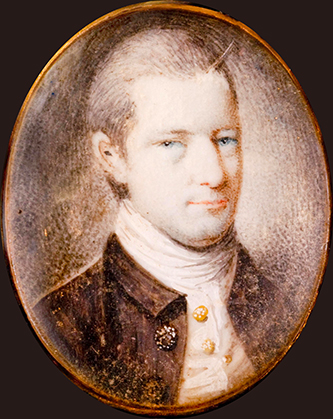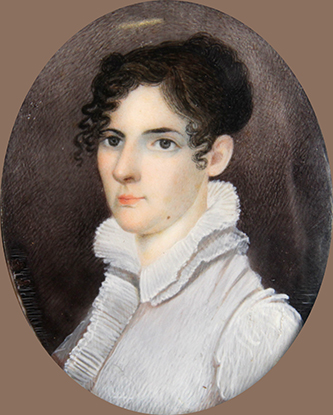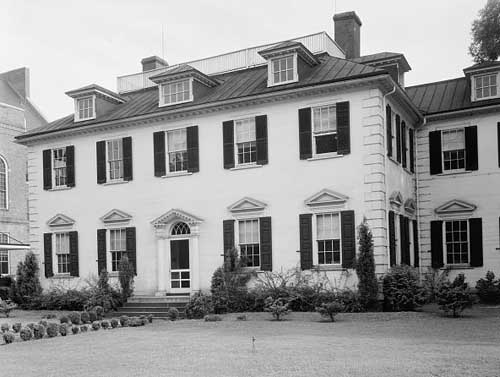18 Dec. 1742–1 June 1789

John Wright Stanly, merchant and Revolutionary Patriot, maintained a fleet of trading and privateering vessels that brought in supplies vital to North Carolina's wartime strength. A native of Charles City County, Va., he arrived in New Bern in 1772, in time to become an early member of the town's Committee of Safety and to be among the first to send raiders from that port.
Stanly began life as the oldest son of Dancey, a lawyer and small planter, and his wife, Elizabeth Wright Stanley, of Isle of Wight County. Despite their modest circumstances, the Stanleys had a proud tradition of direct descent from an earl of Derby. Dancey died when John had barely reached the age of fifteen, and Elizabeth promptly remarried. The boy left home to apprentice himself to a Scottish trader in Petersburg from whom he learned the intricacies and disadvantages of colonial commerce under the British mercantile system. The deaths of both his mentor and his mother within two years left him desolate. He worked in Williamsburg (probably as a clerk) until he was twenty-one and could claim his inheritance. Just prior to that time he got into serious trouble leading to an accusation of counterfeiting. His innocence was established before he could come to trial, but his experience in the Williamsburg jail impelled him to leave Virginia as soon as he had sold his property and had a small capital in hand.
Having some acquaintance with Kingston merchants, he began trading in Jamaica, where he had an initial success. This attracted the attention of a Philadelphia merchant, Jonathan Cowpland, who brought a ship regularly to Kingston. He persuaded Stanly (who had dropped the e from his name) to enter into a partnership and then attempted to take over the entire operation. Cowpland accused Stanly of defrauding him and, to blacken the Virginian's name, bruited it about that Stanly had been tried for counterfeiting. But too many people in Jamaica stood ready to defend the young man, so Cowpland took him by force to Philadelphia, where Stanly spent a year in debtors' prison. He managed, finally, to prove that he was the injured party, with Cowpland in his debt, and could once more make a fresh start.

This time he chose Charleston as his base of operations and sailed for that city. A storm off Cape Hatteras brought him to New Bern, instead. Acquaintance with, courtship of, and marriage to Ann Cogdell kept him there. Her father, Richard Cogdell, an ardent Whig, brought Stanly into the group pressing for revolt against the repressive measures of Lord North's government. Risking prosecution as traitors, they did all in their power to induce others to rebel, and Stanly was among the most persuasive.
By the time hostilities broke out, he was ready to send out vessels to harass British shipping and to bring in the sinews of war lacking to the Americans. The most famous of his early privateers, the Sturdy Beggar, despoiled numerous English merchantmen. Stanly worked particularly hard during the bitter winter of 1777–78 to get supplies to the men at Valley Forge, and later his General Nash took prizes, after the Battle of Camden, which helped to replace material lost by General Horatio Gates's forces. Far more numerous than those successes were the losses he suffered—privateers reckoned on the capture or wreck of four vessels to the return of one. Stanly managed, however, to make enough money to give substantial financial aid to General Nathanael Greene in 1780, when Greene marched south with a token army and no funds for its equipment.

As the conflict drew nearer to New Bern, Stanly prepared to shift his operations to Philadelphia and took his family there. Before he could get settled, he learned of the capture of St. Eustatius by the British, which meant the loss of fourteen Stanly vessels loading at Oranjestad, Netherlands Antilles. Then came news that a Tory privateer from New York had seized the brig bringing part of the family's possessions to Philadelphia. Worse trouble followed: in that summer of 1781 Tory raiders and British troops entered New Bern and burned all of Stanly's warehouses as well as dismantling his vessels at anchor. In spite of these setbacks, he invested in eleven Philadelphia privateers that sailed within the year, helping to keep British ships occupied on patrol instead of attacking American ports.
Stanly returned to New Bern with his family in 1782 and at war's end started a coastwide shipping operation that he later reduced, as he found the distillery business more profitable. He had two tremendous satisfactions: appointment as judge of the Admiralty Court of Beaufort and completion of the handsome house in New Bern that still remains as a memorial to him. But enjoyment of both title and house lasted for only a few short years. He succumbed to yellow fever in June 1789—just a month before his wife. They left six living children (three had died in infancy) of whom the eldest, John, became a member of Congress and a leader of the North Carolina bar.